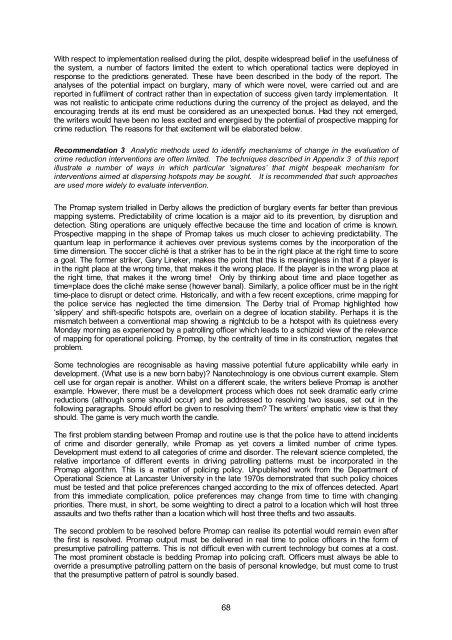Prospective crime mapping in operational context Final report
Prospective crime mapping in operational context Final report
Prospective crime mapping in operational context Final report
- No tags were found...
You also want an ePaper? Increase the reach of your titles
YUMPU automatically turns print PDFs into web optimized ePapers that Google loves.
With respect to implementation realised dur<strong>in</strong>g the pilot, despite widespread belief <strong>in</strong> the usefulness ofthe system, a number of factors limited the extent to which <strong>operational</strong> tactics were deployed <strong>in</strong>response to the predictions generated. These have been described <strong>in</strong> the body of the <strong>report</strong>. Theanalyses of the potential impact on burglary, many of which were novel, were carried out and are<strong>report</strong>ed <strong>in</strong> fulfilment of contract rather than <strong>in</strong> expectation of success given tardy implementation. Itwas not realistic to anticipate <strong>crime</strong> reductions dur<strong>in</strong>g the currency of the project as delayed, and theencourag<strong>in</strong>g trends at its end must be considered as an unexpected bonus. Had they not emerged,the writers would have been no less excited and energised by the potential of prospective <strong>mapp<strong>in</strong>g</strong> for<strong>crime</strong> reduction. The reasons for that excitement will be elaborated below.Recommendation 3 Analytic methods used to identify mechanisms of change <strong>in</strong> the evaluation of<strong>crime</strong> reduction <strong>in</strong>terventions are often limited. The techniques described <strong>in</strong> Appendix 3 of this <strong>report</strong>illustrate a number of ways <strong>in</strong> which particular ‘signatures’ that might bespeak mechanism for<strong>in</strong>terventions aimed at dispers<strong>in</strong>g hotspots may be sought. It is recommended that such approachesare used more widely to evaluate <strong>in</strong>tervention.The Promap system trialled <strong>in</strong> Derby allows the prediction of burglary events far better than previous<strong>mapp<strong>in</strong>g</strong> systems. Predictability of <strong>crime</strong> location is a major aid to its prevention, by disruption anddetection. St<strong>in</strong>g operations are uniquely effective because the time and location of <strong>crime</strong> is known.<strong>Prospective</strong> <strong>mapp<strong>in</strong>g</strong> <strong>in</strong> the shape of Promap takes us much closer to achiev<strong>in</strong>g predictability. Thequantum leap <strong>in</strong> performance it achieves over previous systems comes by the <strong>in</strong>corporation of thetime dimension. The soccer cliché is that a striker has to be <strong>in</strong> the right place at the right time to scorea goal. The former striker, Gary L<strong>in</strong>eker, makes the po<strong>in</strong>t that this is mean<strong>in</strong>gless <strong>in</strong> that if a player is<strong>in</strong> the right place at the wrong time, that makes it the wrong place. If the player is <strong>in</strong> the wrong place atthe right time, that makes it the wrong time! Only by th<strong>in</strong>k<strong>in</strong>g about time and place together astime=place does the cliché make sense (however banal). Similarly, a police officer must be <strong>in</strong> the righttime-place to disrupt or detect <strong>crime</strong>. Historically, and with a few recent exceptions, <strong>crime</strong> <strong>mapp<strong>in</strong>g</strong> forthe police service has neglected the time dimension. The Derby trial of Promap highlighted how‘slippery’ and shift-specific hotspots are, overla<strong>in</strong> on a degree of location stability. Perhaps it is themismatch between a conventional map show<strong>in</strong>g a nightclub to be a hotspot with its quietness everyMonday morn<strong>in</strong>g as experienced by a patroll<strong>in</strong>g officer which leads to a schizoid view of the relevanceof <strong>mapp<strong>in</strong>g</strong> for <strong>operational</strong> polic<strong>in</strong>g. Promap, by the centrality of time <strong>in</strong> its construction, negates thatproblem.Some technologies are recognisable as hav<strong>in</strong>g massive potential future applicability while early <strong>in</strong>development. (What use is a new born baby)? Nanotechnology is one obvious current example. Stemcell use for organ repair is another. Whilst on a different scale, the writers believe Promap is anotherexample. However, there must be a development process which does not seek dramatic early <strong>crime</strong>reductions (although some should occur) and be addressed to resolv<strong>in</strong>g two issues, set out <strong>in</strong> thefollow<strong>in</strong>g paragraphs. Should effort be given to resolv<strong>in</strong>g them? The writers’ emphatic view is that theyshould. The game is very much worth the candle.The first problem stand<strong>in</strong>g between Promap and rout<strong>in</strong>e use is that the police have to attend <strong>in</strong>cidentsof <strong>crime</strong> and disorder generally, while Promap as yet covers a limited number of <strong>crime</strong> types.Development must extend to all categories of <strong>crime</strong> and disorder. The relevant science completed, therelative importance of different events <strong>in</strong> driv<strong>in</strong>g patroll<strong>in</strong>g patterns must be <strong>in</strong>corporated <strong>in</strong> thePromap algorithm. This is a matter of polic<strong>in</strong>g policy. Unpublished work from the Department ofOperational Science at Lancaster University <strong>in</strong> the late 1970s demonstrated that such policy choicesmust be tested and that police preferences changed accord<strong>in</strong>g to the mix of offences detected. Apartfrom this immediate complication, police preferences may change from time to time with chang<strong>in</strong>gpriorities. There must, <strong>in</strong> short, be some weight<strong>in</strong>g to direct a patrol to a location which will host threeassaults and two thefts rather than a location which will host three thefts and two assaults.The second problem to be resolved before Promap can realise its potential would rema<strong>in</strong> even afterthe first is resolved. Promap output must be delivered <strong>in</strong> real time to police officers <strong>in</strong> the form ofpresumptive patroll<strong>in</strong>g patterns. This is not difficult even with current technology but comes at a cost.The most prom<strong>in</strong>ent obstacle is bedd<strong>in</strong>g Promap <strong>in</strong>to polic<strong>in</strong>g craft. Officers must always be able tooverride a presumptive patroll<strong>in</strong>g pattern on the basis of personal knowledge, but must come to trustthat the presumptive pattern of patrol is soundly based.68
















